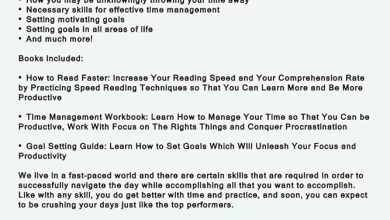How to Assist an Employee Who Struggles With Time management? Explained!

If you’re a manager, you’ve probably had an employee who struggles with time management. Whether they’re always late with deadlines or can’t seem to focus on the most important tasks, it can be frustrating for both you and the employee. Fortunately, there are ways to help your employee improve their time management skills.
The first step is to identify the time management issues that your employee is facing. This can be done through observation, feedback from other team members, or a discussion with the employee. Once you’ve identified the issues, you can work with the employee to develop strategies for improvement. This might include setting SMART goals, prioritizing tasks, or breaking down large projects into smaller, more manageable tasks.
Providing your employee with the right tools and resources can also be helpful. This might include time tracking software, project management tools, or training on time management techniques. Additionally, supporting and coaching your employee throughout the process can go a long way in helping them improve their time management skills. With the right approach, you can help your employee become more productive and successful in their role.
Key Takeaways
- Identifying time management issues is the first step in helping your employee improve.
- Strategies for improvement might include setting SMART goals, prioritizing tasks, or breaking down large projects.
- Providing tools and resources, as well as coaching and support, can help your employee become more productive.
Identifying Time Management Issues

As a manager, it is important to recognize signs of poor time management in your employees. This can include missed deadlines, incomplete tasks, and a general feeling of being overwhelmed. By understanding the impact of poor time management on work quality and deadlines, you can help your employees improve their productivity and reduce their stress levels.
Recognizing Signs of Poor Time Management
Recognizing signs of poor time management is the first step in helping an employee who struggles with time management. These signs can include a lack of focus, procrastination, and difficulty prioritizing tasks. You may also notice that your employee is easily distracted or spends too much time on non-work-related activities.
To help your employee improve their time management skills, it is important to identify the specific challenges they are facing. This can include identifying the tasks that take up the most time, the deadlines that are most difficult to meet, and the distractions that are most tempting.
Understanding the Impact on Work Quality and Deadlines
Poor time management can have a significant impact on work quality and deadlines. When employees struggle with time management, they may rush through tasks or miss important details, which can lead to errors and poor quality work. This can also lead to missed deadlines, which can impact the entire team.
In addition to impacting work quality and deadlines, poor time management can also increase stress levels. When employees feel overwhelmed and unable to manage their workload, they may become anxious and stressed, which can lead to burnout and decreased productivity.
By recognizing the signs of poor time management and understanding the impact on work quality and deadlines, you can help your employees improve their time management skills and reduce their stress levels.
What are the Strategies for Improvement?
If you have an employee who struggles with time management, there are several strategies you can implement to help them improve their skills.
Setting Clear Priorities and Expectations
One effective strategy is to set clear priorities and expectations. This can help your employee understand what tasks are most important and how much time they should allocate to each one. Prioritizing tasks can help your employee focus on the most critical tasks first and ensure that they are completed on time.
Implementing Effective Planning and Scheduling Techniques
Another strategy is to implement effective planning and scheduling techniques. This can include creating timelines and setting deadlines to ensure that tasks are completed on time. The planning fallacy can be avoided by breaking down large tasks into smaller, more manageable tasks and estimating the time required for each one. Time blocking and the Pomodoro technique can also be useful tools to help your employee manage their time effectively.
Teaching Time Management Techniques
Finally, teaching time management techniques can be an effective way to help your employee improve their skills. This can include techniques such as setting goals, creating to-do lists, and avoiding distractions. Encouraging your employee to take breaks and recharge can also help them stay focused and productive throughout the day.
By implementing these strategies, you can help your employee improve their time management skills and become more productive and efficient in their work.
Tools and Resources For Employee
As an employer, you can help your employees with time management by providing them with the right tools and resources. Here are a few options to consider:
Utilizing Project Management Software
Project management software can help your employees stay organized and on track with their tasks. With features like task lists, deadlines, and progress tracking, project management software can help your employees prioritize their work and manage their time effectively. Some popular project management software options include Asana, Trello, and Basecamp.
Leveraging Time Tracking and To-Do Lists
Time tracking tools can help your employees become more aware of how they’re spending their time. By tracking the time spent on various tasks, your employees can identify areas where they’re wasting time and make adjustments accordingly. To-do lists can also be helpful, as they allow employees to break down larger tasks into smaller, more manageable steps. Some popular time tracking and to-do list tools include Toggl, RescueTime, and Todoist.
Overall, providing your employees with the right tools and resources can help them become more productive and better manage their time. Consider implementing project management software, time tracking tools, and to-do lists to help your employees stay organized and focused on their tasks.
Supporting and Coaching Employees
As a manager, it’s essential to support and coach employees who struggle with time management. By doing so, you can help them develop their skills and improve their performance. Here are two ways to support and coach employees:
Offering Regular Feedback and Communication
Regular feedback and communication are crucial to helping employees improve their time management skills. As their manager, you should provide constructive feedback on their performance, offer suggestions for improvement, and communicate regularly to ensure they are on track. By doing so, you can help them stay motivated and focused on their goals.
Developing a Culture of Collaboration and Support
Developing a culture of collaboration and support can also help employees improve their time management skills. Encourage team members to work together, share ideas, and support each other. As a coach, you can facilitate this by providing opportunities for collaboration, such as team-building activities or brainstorming sessions. By doing so, you can help employees develop a sense of ownership and accountability for their work, which can lead to improved time management skills.
Overall, supporting and coaching employees who struggle with time management is essential for their success. By offering regular feedback and communication and developing a culture of collaboration and support, you can help your direct reports become more effective and efficient in their work.
Frequently Asked Questions
What strategies can be implemented to improve an employee’s time management skills?
To help your employee improve their time management skills, consider implementing strategies such as setting clear goals and deadlines, creating a prioritized task list, and encouraging the use of time-tracking tools. Additionally, providing regular feedback and coaching can help your employee understand where they can improve and how to do so.
What motivational techniques can be used to encourage employees to prioritize time management?
Motivating employees to prioritize time management can be achieved through a variety of techniques, such as offering rewards for timely completion of tasks, providing recognition for good time management skills, and setting realistic goals that are achievable within a given timeframe. It is important to ensure that your motivational techniques are tailored to each employee’s individual needs and preferences.
How should a manager address an employee’s consistent failure to complete tasks on time?
When addressing an employee’s consistent failure to complete tasks on time, it is important to approach the situation with empathy and understanding. Start by identifying the root cause of the issue, such as a lack of resources or unclear expectations. Then, work with the employee to create a plan for improvement, setting clear goals and deadlines and providing support and feedback along the way. If necessary, consider providing additional training or resources to help the employee improve their time management skills.
Final Words
In conclusion, helping an employee who struggles with time management requires patience, empathy, and effective communication. By understanding the root cause of their time management issues, setting clear goals and expectations, and providing the necessary resources and support, you can help your employee improve their time management skills and boost their productivity. Remember to be flexible and adapt your approach as needed to ensure that your employee feels supported and empowered to succeed. With these strategies in mind, you can help your team thrive and achieve their goals.


